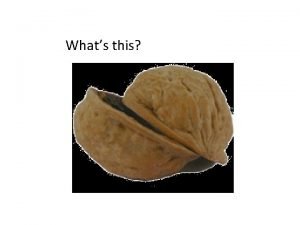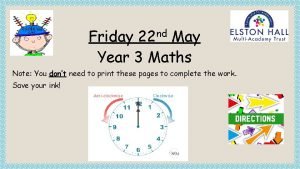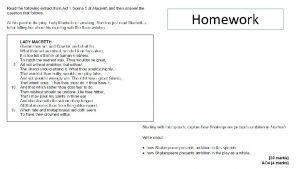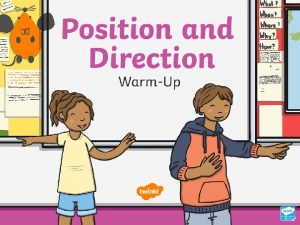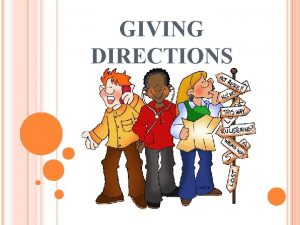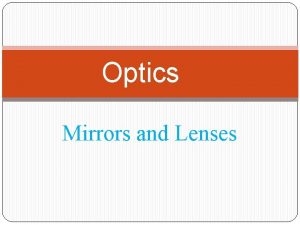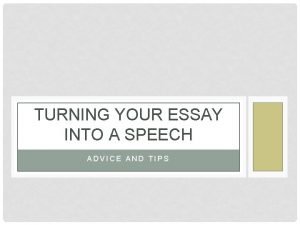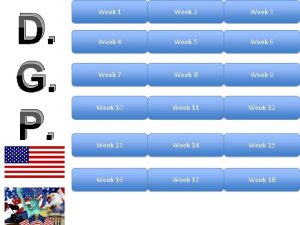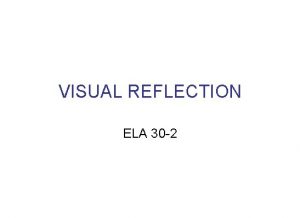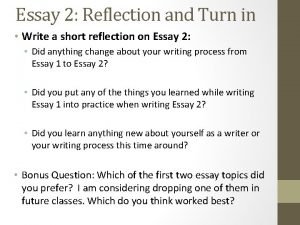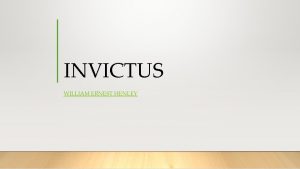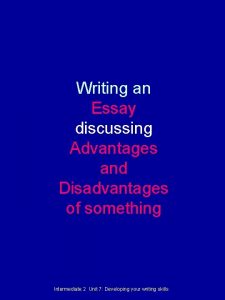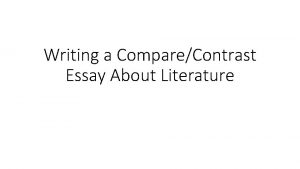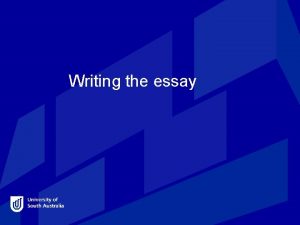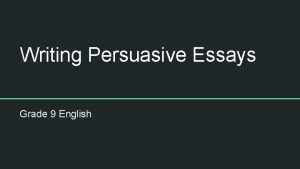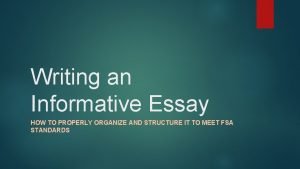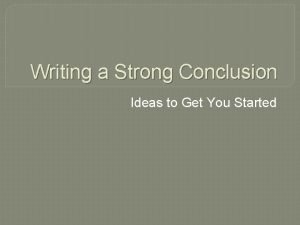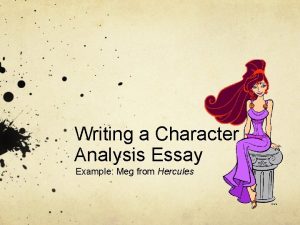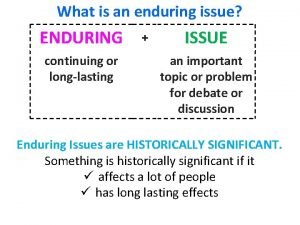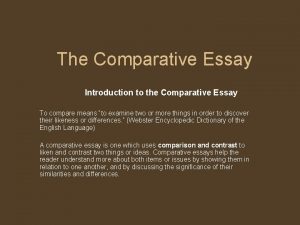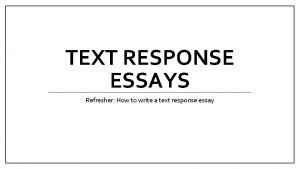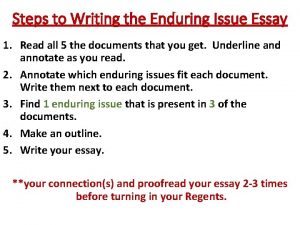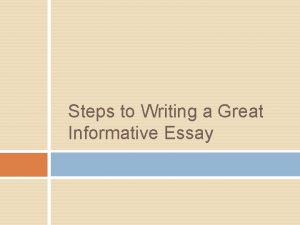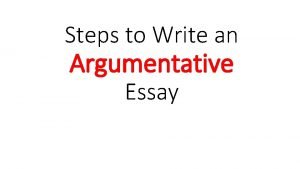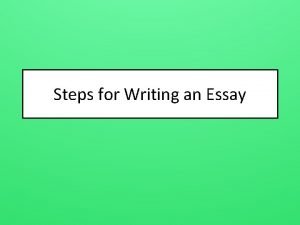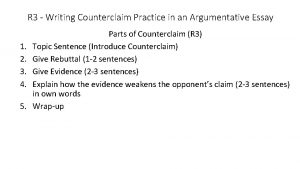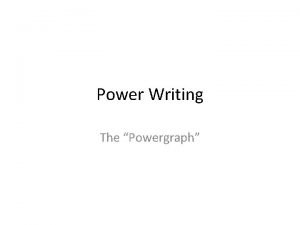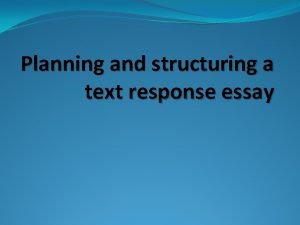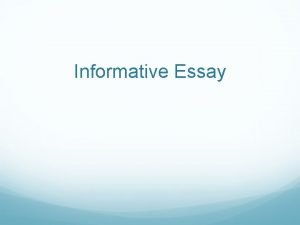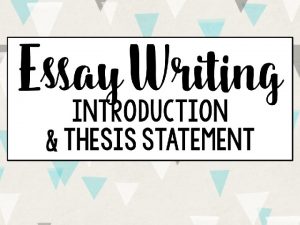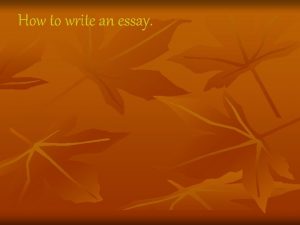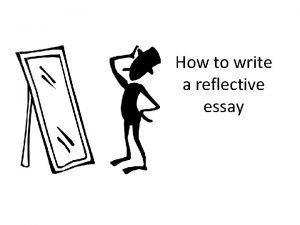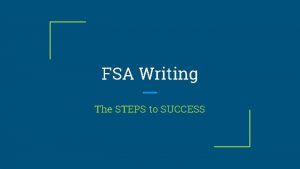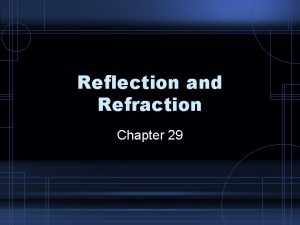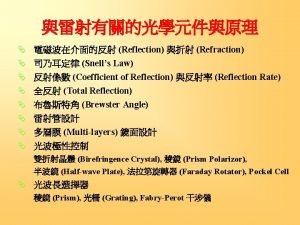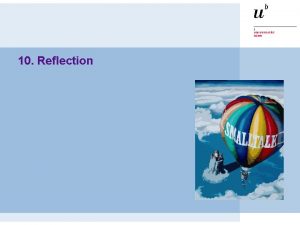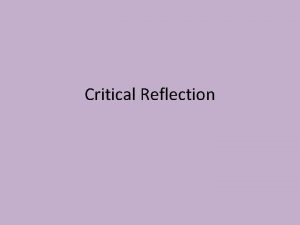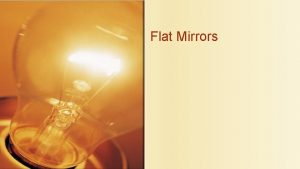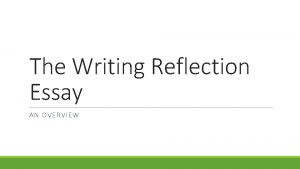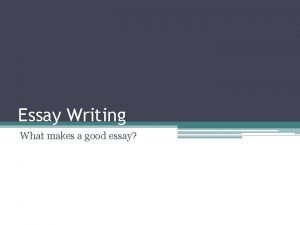Essay 2 Reflection and Turn in Write a



















































- Slides: 51

Essay 2: Reflection and Turn in • Write a short reflection on Essay 2: • Did anything change about your writing process from Essay 1 to Essay 2? • Did you put any of the things you learned while writing Essay 1 into practice when writing Essay 2? • Did you learn anything new about yourself as a writer or your writing process this time around? • Bonus Question: Which of the first two essay topics did you prefer? I am considering dropping one of them in future classes. Which do you think worked best?

Sentence Clarity A workshop brought to you by the Purdue University Writing Lab

Sentence Clarity Why worry about making sentences clear? • To communicate effectively with the reader • To make writing persuasive and interesting • To show credibility and authority as a writer

Common Clarity Concerns This presentation will cover 4 topics: • Misplaced modifiers • Dangling modifiers • Parallel Structures • Passive Voice

Misplaced Modifiers • Modifier – Describes, clarifies, or gives more detail about other words in a sentence – Can be a word or group of words (phrase) • Misplaced modifier – A modifier in the wrong place in a sentence – Makes sentences awkward, confusing, or (unintentionally) humorous

Misplaced Modifiers (cont) • Do these sentences have different meanings? Why? – The dog under the tree bit Carrie. – The dog bit Carrie under the tree.

Misplaced Modifiers (cont) • Sometimes modifiers are intentionally used for comic effect: “The other day I shot an elephant in my pajamas. How he got in my pajamas I’ll never know. ” – Groucho Marx

Misplaced Modifiers (cont) • How can you correct this sentence? – Buffy called her adorable kitten opening the can of food and filled the bowl. • Process: – What is the modifier? – What word does it describe, clarify, or give more detail about? – Where should the modifier be placed? » Modifiers go next to the word or phrase they modify.

Misplaced Modifiers (cont) • Misplaced modifier: – Buffy called her adorable kitten opening the can of food and filled the bowl. • Correctly placed modifier: – Opening the can of food, Buffy called her adorable kitten and filled the bowl.

Misplaced Modifiers (cont) • How can you correct this sentence? – Portia rushed to the store loaded with cash to buy Guy’s birthday present. • Process: – What is the modifier? – What word does it describe, clarify, or give more detail about? – Where should the modifier be placed? » Modifiers go next to the word or phrase they modify.

Misplaced Modifiers (cont) • Misplaced modifier: – Portia rushed to the store loaded with cash to buy Guy’s birthday present. • Correctly placed modifier: – Portia, loaded with cash, rushed to the store to buy Guy’s birthday present.

Misplaced Modifiers (cont) • One-word modifiers that limit can easily be misplaced. These include: – Almost, even, exactly, hardly, just, merely, nearly, only, scarcely and simply • To be clear, place the modifier immediately before the word or phrase you want to limit.

Misplaced Modifiers (cont) • Which sentence indicates that everyone in the class failed the exam? – Almost everyone in the class passed the calculus exam. – Everyone in the class almost passed the calculus exam.

Misplaced Modifiers (cont) • Which sentence indicates that Jean-Luc earned some money? – Jean-Luc nearly earned $100. – Jean-Luc earned nearly $100.

Misplaced Modifiers (cont) • Review – Misplaced Modifier: • modifier in the wrong place in a sentence – Process to correct misplaced modifiers: • What is the modifier? • What word does it describe, clarify, or give more detail about? • Where should the modifier be placed? – Modifiers go next to the word or phrase they modify. – One-word, limiting modifiers go directly before the word or phrase they modify

Dangling Modifiers • Dangling Modifier: – does not sensibly modify anything in its sentence • modifier is present, but it has nothing to modify – often occur at the beginning or end of a sentence – often indicated by an –ing verb or a to + verb phrase

Dangling Modifiers (cont) • What is the modifier modifying? – Having finished dinner, the rugby match was turned on. • Remember, modifiers go next to the words or phrases they modify.

Dangling Modifiers (cont) • 3 ways to fix dangling modifiers: – Name the appropriate doer of the action as the subject of the main clause • Having finished dinner, Jude turned on the rugby match. – Place the subject of the action within the dangling modifier: • After Jude finished dinner, he turned on the rugby match. – Combine the phrase and clause. • Jude turned on the rugby match after finishing dinner.

Dangling Modifiers (cont) • How might you correct the following sentence? – Playing solitaire on the computer for three hours, Michael’s paper was not finished. – Michael’s paper was not finished because HE was playing solitaire on the computer for three hours. – Michael played solitaire on the computer for three hours, so his paper was not finished. • Process: – – What is the modifier? What word does it describe, clarify, or give more detail about? Do you need to insert doer? Where should the modifier be placed? » Modifiers go next to the word or phrase they modify

Dangling Modifiers (cont) • 3 revised sentences with connected modifiers: – Playing solitaire on the computer for three hours, Michael did not complete his paper. – Because Michael played solitaire on the computer for three hours, he did not complete his paper. – Michael did not complete his paper because he played solitaire on the computer for three hours.

Dangling Modifiers (cont) • How might you revise the following sentences? – To work as a loan officer, an education in financial planning is required. – To improve her grade, the test was completed again. – After reading the original study, the article remains unconvincing.

Dangling Modifiers (cont) • Possible revisions: – To work as a loan officer, one needs an education in financial planning. – She repeated the test to improve her grade. – After reading the original study, I find the article unconvincing.

Dangling Modifiers (cont) • Review – Dangling modifier: • modifier is present, but it has nothing to modify • often occur at the beginning or end of a sentence • often indicated by an –ing verb or a to + verb phrase – Process to correct dangling modifiers: • Name the appropriate or logical doer of the action as the subject of the main clause • Place the subject of the action within the dangling modifier: • Combine the phrase and clause.

Exercises: • Page 249 • Do sentences 1 through 5.

Please return in 10 -15 minutes BREAK TIME

Parallel Structure • Parallel Structure: • “Using the same pattern of words to show that 2 or more ideas are equally important. ” – Applies to words, phrases, or clauses – Usually use coordinating conjunctions ("and, ” "or”) to join parallel structures.

Parallel Structure (cont) • NOT parallel: – Mary likes hiking, to swim, and ride her bike. • Parallel: – Mary likes to hike, to swim, and to ride a bicycle. OR – Mary likes to hike, swim, and ride a bicycle. OR – Mary likes hiking, swimming, and bicycling. Note: Use "to" before all the verbs in a sentence or only before the first one—don’t mix.

Parallel Structure (cont) • Clause: – group of words containing a subject + a verb which forms part of a sentence • A parallel structure that begins with clauses must continue with clauses. – The coach told the players that they should get a lot of sleep, not eat too much, and do some warm-up exercises before the game.

Parallel Structure (cont) Which sentences show parallel structure? • Dino does not like to sing, dance, or acting. • Dino does not like singing, dancing, or acting. • The production manager was asked to write his report quickly, accurately, and in a detailed manner. • The production manager was asked to write his report quickly, accurately, and thoroughly.

Parallel Structure (cont) Which sentences show parallel structure? • Dino does not like to sing, dance, or acting. NO • Dino does not like singing, dancing, or acting. YES • The production manager was asked to write his report quickly, accurately, and in a detailed manner. NO. • The production manager was asked to write his report quickly, accurately, and thoroughly. YES.

Parallel Structure (cont) Which sentences show parallel structure? • Aldus was a poor student because he waited until the last minute to study, was always completing his lab problems carelessly, and his motivation was low. • Aldus was a poor student because he waited until the last minute to study, completed his lab problems carelessly, and lacked motivation.

Parallel Structure (cont) Which sentences show parallel structure? • Aldus was a poor student because he waited until the last minute to study, was always completing his lab problems carelessly, and his motivation was low. NO • Aldus was a poor student because he waited until the last minute to study, completed his lab problems carelessly, and lacked motivation. YES

Parallel Structure (cont) • How can you correct this sentence? The sales rep expected that she would present her product at the meeting, there would be time for her to show her slide presentation, questions would be asked by prospective buyers.

Parallel Structure (cont) • Parallel: – The sales rep expected • that she would present her product at the meeting, • That she would show her slide presentation, • and • That prospective buyers would ask questions. » Note each clause starts with “that” + subject + “would” + verb • The sales rep expected that she would present her product at the meeting, that she would show her slide presentation, and that prospective byers would ask questions.

Parallel Structure (cont) • Lists after a Colon: – Be sure to keep all the elements in a list in the same form. What’s wrong with this sentence? • The dictionary can be used for these purposes: to find word meanings, pronunciations, correcting spelling, and look up irregular verbs.

Parallel Structure (cont) Proofreading strategies for parallel structure: 1. Skim your paper, pausing at "and" and "or. " Check on each side of these words to see if the joined items are parallel. 2. If you have several items in a list, put them in a column and see if they “match”. 3. Read your writing out loud. Listen to the sound of the items in a list or the items being compared. Do you hear the same kinds of sounds? Do your hear a “rhythm”? – If something breaks that rhythm or repetition of sound, check if it needs to be made parallel.

Review the Prompt for the Take-Home Midterm Essay • Pass out the prompt and discuss

Take-Home Midterm Essay • For this essay, I will allow you to some general reading on the topic before you write your essay, but you are NOT allowed to copy any word-for-word information from online sources or other outside sources. • Treat this like an in-class essay. • DO NOT copy/paste from any online source and DO NOT copy information or sentences from any outside source. • You can and should write this essay based on • a) the reading I gave you, • b) the reading from your textbook due next week, • c) your own experience, knowledge, and thoughts about the topic.

Take-Home Midterm Writing Tips • Step 1: Read the prompt carefully. • Underline key words. • Figure out what kind of response the question is looking for. • Make sure you give the correct type of response. • Step 2: Plan. • Writing down ideas/things to cover may help you to remember them later. • Write down your thesis (your claim) somewhere in your outline. • Also include main ideas and a several supporting ideas/phrases for each body paragraph.

Take-Home Midterm Writing Tips • Step 3: Write. • Make sure that you are following any special directions like double spacing and no copying from sources. • Pace yourself. • Spend the most time on the body of your essay, not introducing or planning or writing your conclusion. • Make sure that each paragraph has a good topic sentence that will help keep you on track for that paragraph. • Step 4: Check Yourself. • Take the opportunity to go back and look for grammar and spelling errors, or for places where you might need to add clarification.

REVIEW: The Basic Parts of an Essay • The basic parts of an essay: • Introduction • Body • Conclusion

First Paragraph: Introduction • The purpose of an introduction is to set your reader up for the rest of the essay: • Catch your reader’s attention, and get them interested in the topic. • Give the some BREIF background on the topic if they need it to understand your main idea. • Give them your main idea (thesis) that you will be expanding on and supporting in the rest of the essay.

Body Paragraphs – Topic Sentences, Support, Examples and Transitions • This is the main part of your essay. • This is where you expand on your topic and support you thesis with vivid description, background and explanations, and reflection on the significance of the events you are describing. • Organize your body paragraphs so that each body paragraph has a main point that connects to the main point (thesis) of your entire essay. • Make sure that the paragraphs are organized in a logical manner. Remember: you can move your paragraphs around!

What is a paragraph? • A paragraph is a group of sentences that work together for a common purpose. • All of the sentences in a paragraph are about the same general topic. • Each sentence works with the others in order to achieve the purpose of the paragraph. • Paragraphs contain a topic sentence and two different types of support: primary support and secondary support. • Each new paragraph is indented five spaces.

What is a topic sentence? • Your topic sentence introduces the main idea of your paragraph. • A topic sentence has two parts: a topic an a controlling idea. – Your topic is what the paragraph is about. – Your controlling idea is the opinion or idea about the topic that the paragraph will explain.

Example Topic Sentences • Let’s say that you were writing a paragraph about the topic “Cell phones. ” There are many different ideas or opinions about cell phones that you could explore, so it’s important to pick just one. You might write… – Cell phones that can connect to the internet have changed the way people shop. – Cell phones and texting should be banned during class time.

Supporting Your Topic Sentence • When you have decided what your topic and your controlling idea will be, it is time to support your topic sentence. – Primary support points are the major ideas that support your topic sentence. (They are usually general rather than specific. ) – Secondary support points are specific examples and details that back up your primary support.

Example Paragraph Outline • Topic Sentence: Cell phones that can connect to the internet have changed the way people shop. • Primary support 1: Able to check reviews online. • • Secondary support: Checked reviews for digital camera at Best Buy. Secondary support: Check reviews of new authors at amazon. com before buying at Borders. • Primary support 2: Able to compare prices at other stores while shopping. • • Compared prices for Sherlock Holmes movie on the first day it was out. Compared prices for new flash drive when I lost my old one. • Primary support 3: Able to use coupons without ever printing them out. • • Used a 40% off coupon scanned off of my room mate’s i. Phone at Borders last week. Used an emailed coupon at a candle store last month.

Completed Paragraph Cell phones that can connect to the internet have changed the way people shop. First of all, customers can immediately check reviews online before making a decision. When I was shopping for a digital camera at Best Buy, I used an i. Phone to see which brand had the most positive reviews. Also, when I buy a book by a new author at Borders, I sometimes check reviews of his or her books at amazon. com first. Second, customers can compare prices at other stores while they are out shopping. When the new Sherlock Holmes movie came out, I compared prices online and was surprised to find that Target had a better price than some online discount stores. I also compared prices using a cell phone when I lost my flash drive and had to buy a new one. Finally, customers are able to use instore coupons without ever printing them out, which saves a lot of money, paper, and ink. Last week, I used a 40% off coupon scanned off of my room mate’s i. Phone at Borders, and last month, I used a coupon that had been emailed to me at a candle store. In these ways, cell phones are making it easier for customers to find the best deals and make informed decisions.

Last Paragraph: The Conclusion • The purpose of a conclusion is to conclude your essay in a way that lets your reader understand in a BREIF FORM what they have just read. • Imagine it this way: You have just taken your reader on a journey in your essay. The purpose of the intro is to give your reader a mental "map" or preview of where you are going to take them. • The purpose of the conclusion is to show them where they have been, yes, but also to emphasize the basic essential points you want them to walk away with. • What do you really want them to remember and think about AFTER they are finished reading? THAT is the purpose of a conclusion.

Next Week: • Week 12 – Tuesday, November 17 • In Class: Introducing Essay 4: the Informative Essay. • Due: • Essay 3 the Out-of-Class Midterm Essay IS DUE • Read “Credit Card Smarts: Take Charge of Your Card” pg. 146
 Tomato flames
Tomato flames You can't turn right here. you turn left.
You can't turn right here. you turn left. Wash your hands put on your nightgown analysis
Wash your hands put on your nightgown analysis Answer. go straight turn left turn right
Answer. go straight turn left turn right Turn the arrow 1/4 turn clockwise
Turn the arrow 1/4 turn clockwise Macbeth o valiant cousin worthy gentleman
Macbeth o valiant cousin worthy gentleman Macbeth seeing banquo's ghost quote
Macbeth seeing banquo's ghost quote It's on your left
It's on your left Themes about guilt
Themes about guilt Put your right hand in the air
Put your right hand in the air Go straight ahead and turn left
Go straight ahead and turn left Diverging lens negative focal length
Diverging lens negative focal length Now it's your turn write
Now it's your turn write How to turn essay into speech
How to turn essay into speech Proper adjective for steinbeck
Proper adjective for steinbeck Lab report reflection example
Lab report reflection example Visual reflection pictures
Visual reflection pictures Reflective summary example
Reflective summary example Invictus poem imagery
Invictus poem imagery What is reflective property
What is reflective property Pros and cons of using internet
Pros and cons of using internet Ielts advantages and disadvantages essay vocabulary
Ielts advantages and disadvantages essay vocabulary How to write compare and contrast essay
How to write compare and contrast essay Karakteristik write through didalam write policy
Karakteristik write through didalam write policy Dare paragraph
Dare paragraph Example of academic writing
Example of academic writing Persuasive essay examples grade 9
Persuasive essay examples grade 9 How to do informative essay
How to do informative essay How to write conclusion for essay
How to write conclusion for essay Character essay example
Character essay example What is a enduring issue
What is a enduring issue Thematic essay examples
Thematic essay examples Enduring issues essay example
Enduring issues essay example Comparative essay intro
Comparative essay intro How to write a conclusion for a text response essay
How to write a conclusion for a text response essay How to write an enduring issue essay
How to write an enduring issue essay Steps to writing an informative essay
Steps to writing an informative essay Steps to writing an argumentative essay
Steps to writing an argumentative essay How to write a counterclaim
How to write a counterclaim Counterclaim transition words
Counterclaim transition words Power paragraph example
Power paragraph example Introduction text response essay
Introduction text response essay How to write a hook for a literary analysis essay
How to write a hook for a literary analysis essay How to write a hook for a literary analysis essay
How to write a hook for a literary analysis essay Informative essay vs expository
Informative essay vs expository Informative essay examples
Informative essay examples 200-250 words essay
200-250 words essay How to write reflective essay
How to write reflective essay Poem analysis essay
Poem analysis essay An informative paragraph
An informative paragraph How to write an fsa essay
How to write an fsa essay Fsa essay
Fsa essay


